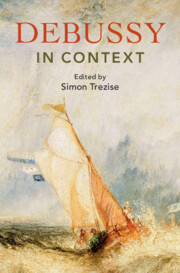Book contents
- Debussy in Context
- Composers in Context
- Debussy in Context
- Copyright page
- Dedication
- Contents
- Illustrations
- Contributors
- Preface
- Notes on the Text
- Abbreviations
- Part I Paris: City, Politics, and Society
- Part II The Arts
- Part III People and Milieu
- Part IV Musical Life: Infrastructure and Earning a Living
- Part V The Music of Debussy’s Time
- Chapter 23 Composing for Opera and Theatre outside Established Genres
- Chapter 24 Ballet and Dance
- Chapter 25 Orchestral Music and Symphonic Traditions
- Chapter 26 Chamber Music
- Chapter 27 Song and Choral Music
- Chapter 28 The Piano
- Part VI Performers, Reception, and Posterity
- Recommendations for Further Reading and Research
- Index
Chapter 26 - Chamber Music
from Part V - The Music of Debussy’s Time
Published online by Cambridge University Press: 23 May 2024
- Debussy in Context
- Composers in Context
- Debussy in Context
- Copyright page
- Dedication
- Contents
- Illustrations
- Contributors
- Preface
- Notes on the Text
- Abbreviations
- Part I Paris: City, Politics, and Society
- Part II The Arts
- Part III People and Milieu
- Part IV Musical Life: Infrastructure and Earning a Living
- Part V The Music of Debussy’s Time
- Chapter 23 Composing for Opera and Theatre outside Established Genres
- Chapter 24 Ballet and Dance
- Chapter 25 Orchestral Music and Symphonic Traditions
- Chapter 26 Chamber Music
- Chapter 27 Song and Choral Music
- Chapter 28 The Piano
- Part VI Performers, Reception, and Posterity
- Recommendations for Further Reading and Research
- Index
Summary
Unlike operatic and orchestral music, chamber music, in common with song, thrived in the salons and the Société nationale. It was a rich period for chamber-music composition, with many works establishing a distinctively French style for genres like the string quartet (just as the French symphony came to distinguish itself from German models). Debussy was at his least idiosyncratic in his one published string quartet, which may be seen as an attempt to conform to expectations, at least in some aspects of the genre. Late in life he chose to distil the most personal features of his style in six chamber works, which pay tribute to remote French traditions, even though only three of these works were completed. The chapter concludes with a consideration of some of the attempts to complete Debussy’s incomplete set of six sonatas, of which he lived to complete only three.
- Type
- Chapter
- Information
- Debussy in Context , pp. 240 - 247Publisher: Cambridge University PressPrint publication year: 2024

